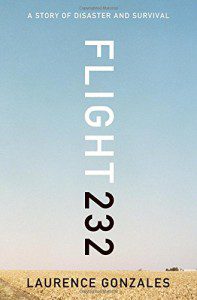
I have a confession: I did not want to read Laurence Gonzales’ latest book, Flight 232. Reading an in-depth account of a plane crash that happened in 1989 didn’t seem like my idea of a good summer book. But I admire Gonzales’ writing immensely, and have learned so much about resilience and human courage from his other books, Deep Survival and Surviving Survival, that I reluctantly cracked the spine of Flight 232. Little did I know I would be reading a page-turner, one that showed ordinary Americans facing the greatest trauma of their lives, irrevocably altering the course of their time on earth.
Flight 232 is many things: it is a book that bears witness to the dead, and to the extraordinary courage of ordinary people; it is a thriller, with a mystery at its core: what made this beautiful plane lose an engine and then lose all hydraulic power? How did the pilots on board manage to maneuver it during that last half hour before it crashed, when, without hydraulic control, it should have been completely uncontrollable? What made the difference between life and death for the passengers on board, some of whom walked away unscathed, picking up briefcases or purses from among the rows of sweet corn, while others were crushed to death or died in toxic clouds of smoke? Flight 232 is also a science lesson on the properties of titanium: how it is made, how it is tested for faults, and how it withstands the almost incomprehensible stress of powering an engine.
At the heart of the mystery of why the plane went down is another, deeper, mystery: why the hand of fate is so random, and how those who are spared at the edge of the abyss choose to make sense of their reprieve. This is where Gonzales is at his best, and where the account of one plane crash becomes a universal quest for courage and resilience. His comprehensive interviews with the survivors are deeply moving accounts of how humans respond to trauma, and Gonzales brings their struggles to life. The book solves the mystery of why the flight crashed, and it is a gripping, suspenseful resolution; Gonzales examines the deeper mystery through the lens of individual responses to tragedy, and these stories are equally powerful.
Gonzales is astonishingly good at detailing individuals’ reactions to escaping death. Some surprise us with their resilience: after the crash, Japanese exchange student Aki Muto grew up to become a flight attendant for Finnair. Others, tragically, never recover, never fly again.
Yisroel Brownstein, a nine-year old boy traveling alone, was protected by businessman Richard Howard Sudlow, who not only helped the boy pray just after takeoff, but later, when it became clear the plane was going to crash, protected him with his own body, paying with his life. Brownstein, like the others, was not the same person after the crash. He didn’t fit in anymore with his conservative Jewish community, and found himself smoking and doing a lot of MMA (mixed martial arts):”So I’m always, like, bruised and bleeding.”

Having been spared, it was as though Brownstein couldn’t stop daring death to do its worst. This echoes the central theme of many of Gonzales’ books, which are, at heart, studies of trauma and resilience. Those who survived, whether they walked into the golden Iowa cornfields with a few scratches, or fought their way back through months of treatment for burns and broken bones, were forced to live dramatically different lives than the ones they’d known before the crash. There was surviving the crash, and then, as Gonzales would put it, there was surviving survival.
Everyone on board knew, or came to know, during that harrowing three quarters of an hour before the crash, that something was terribly wrong. They knew it in different ways, depending on their level of expertise and familiarity with planes. DC-10 instructor Dennis Fitch happened to be a passenger on board. Fitch knew as soon as he went into the cockpit to help. He knew the minute he looked at the crew and the navigational system. Fitch said, “The first thing that strikes your mind is, Dear God, I’m going to die this afternoon. The only question that remains is how long is it going to take Iowa to hit me? That’s a very compelling moment in your life. ”
One heartbreaking fact I took away from Flight 232 is the shocking lack of secure seating required for children. Lap children, as they are known by the airline industry, are kids and infants not required to purchase a seat of their own. They can be held in their parents’ arms, to save the cost of the fare. I don’t judge; I’ve done this myself. But I didn’t envision what happens to these children in a crash. Adults are told to put their babies on the floor at their feet, cushioning them with pillows and blankets. But flight attendants such as Jan Brown know what this means in a crash. As Gonzales writes, “Brown gradually realized that she had been given an impossible job: to keep all passengers safe. Yet she could never protect one class of passengers: babies.” When the aircraft hit, it hit hard, and those unsecured babies and toddlers were thrown all over the cabin. Few of these lap children made it out alive. It would be a wonderful observance of the anniversary of the crash if the FAA would require all passengers to have seats, and would protect people without discrimination based on age. Tragically, the laws remain the same today as they did in 1989.
I have a final confession: I didn’t want to read Flight 232 because I already dread flying. I never liked flying much, but after being airborne over the Atlantic on 9/11, I developed deeper fears. Perhaps it was the faces of the stewardesses, one of whom had silent tears rolling down her face as our plane was diverted to a different city, and no one on board would reveal the details of the global emergency that awaited us. After we landed the news came out little by little that the world had forever changed. Perhaps it was those moments just before landing when I looked at my partner and our son sleeping on the seat between us, and prepared to meet the end. Of course we weren’t in any real danger. These days I force myself to fly, but I don’t much like it, and I didn’t figure reading a book about a crash would be good medicine. I was wrong.
The truth is, as all those who survived Flight 232 know, as all those who’ve contemplated the end of their time on this planet know, only a thin membrane separates the dead from the living. Perhaps we don’t contemplate the end nearly often enough. We live our lives as if they will never change, but they can change in the time it takes an engine to fail, or a plane to merge with the side of a skyscraper. Surely we would do well to learn from those who have been held in the arms of death and then released.




